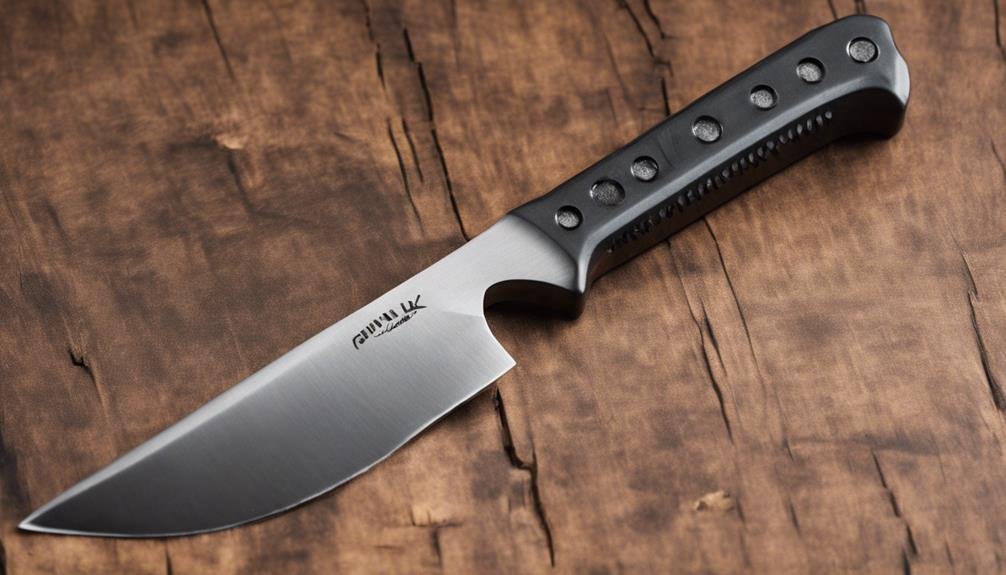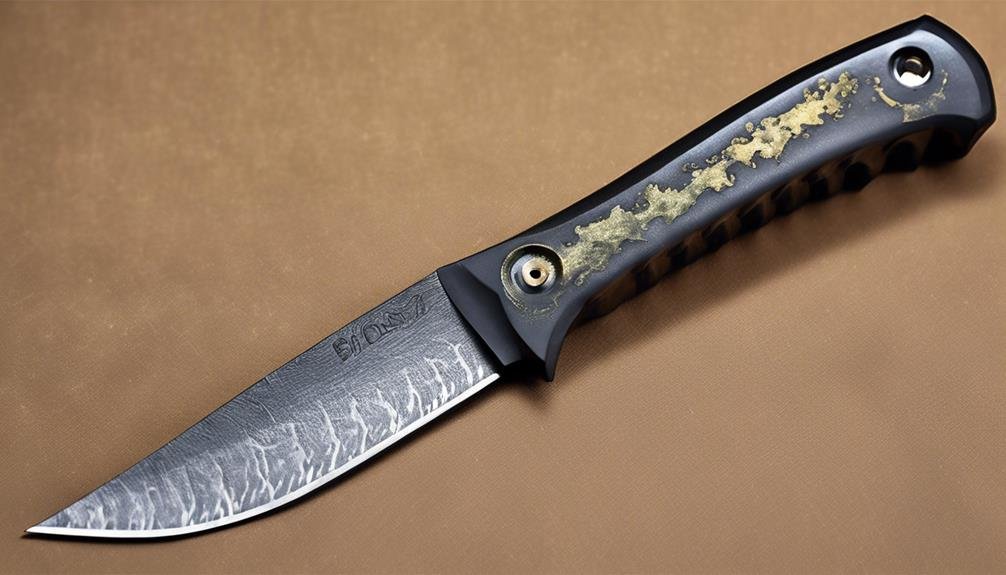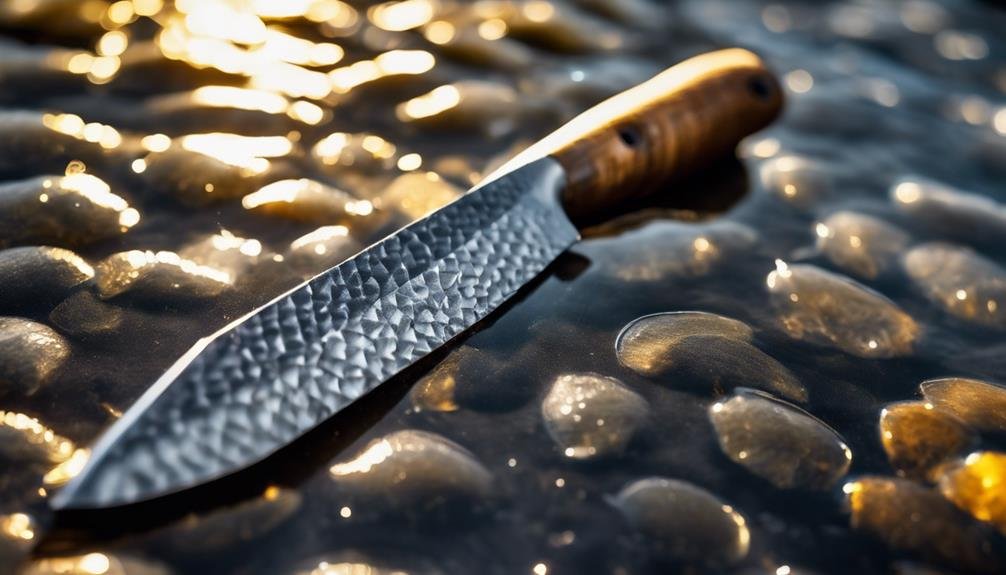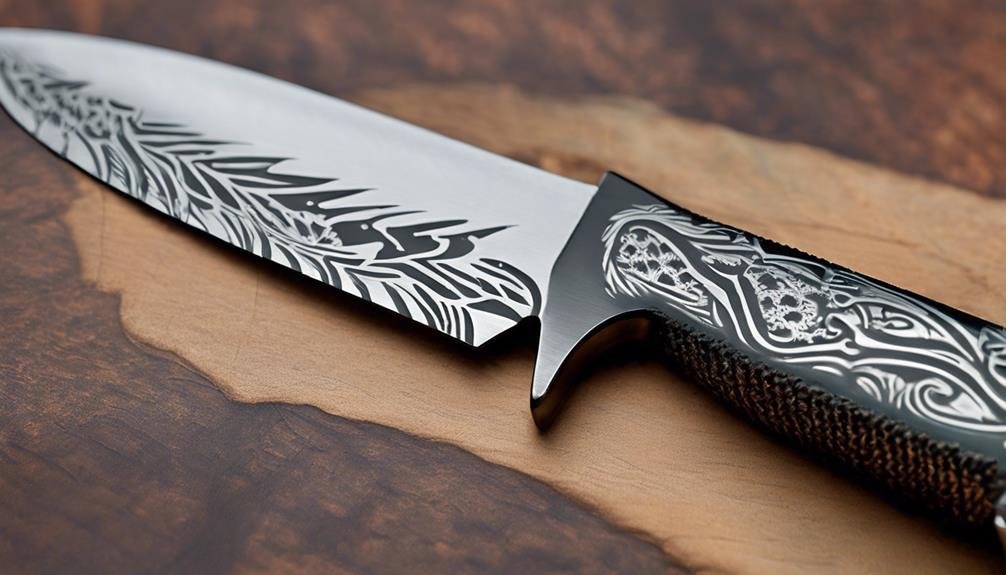Did you know that high-carbon steel blades for fishing knives can provide unmatched sharpness and durability for your angling adventures? These blades offer a level of precision cutting that might surprise you, especially in challenging fishing environments. But how exactly can high-carbon steel blades elevate your fishing experience and guarantee you always have a reliable tool at hand? The answer lies in their superior hardness and edge retention, promising extended periods of peak performance. Want to know more about how these blades can enhance your fishing game?
Key Takeaways
- Maintain a precise sharpening angle of 15-20 degrees.
- Use a sharpening guide for consistent angle maintenance.
- Ensure even beveling and edge alignment for enhanced cutting.
- Regularly use a honing rod to maintain blade sharpness.
- Clean after use, thoroughly dry, and store in a cool, dry place for longevity.
Benefits of High-Carbon Steel Blades
When selecting fishing knives, opt for high-carbon steel blades for unmatched sharpness and durability in handling challenging fishing tasks. High-carbon steel blades excel in maintaining a sharp edge, important for precision cutting during fishing activities. The carbon content in these blades greatly enhances their hardness, making them ideal for slicing through tough materials like fish scales and bones with ease. Additionally, high-carbon steel blades offer exceptional edge retention, ensuring that you can rely on their sharpness throughout your fishing expedition.
These blades are highly resistant to wear and abrasion, guaranteeing long-lasting performance in the demanding environments where fishing often takes place. In addition, the ease of sharpening high-carbon steel blades provides anglers with the convenience of maintaining a razor-sharp edge for efficient filleting and fish processing. With proper care and maintenance, high-carbon steel blades prove to be a reliable cutting companion for all your fishing needs, making them the preferred choice among seasoned anglers seeking excellent performance from their equipment.
Superior Hardness and Sharpness
High-carbon steel blades demonstrate superior hardness and sharpness, essential for precise cutting tasks and prolonged edge retention in fishing knives. The high carbon content in these blades plays an essential role in their remarkable hardness, enabling them to maintain a razor-sharp edge over extended periods of use. This exceptional sharpness is a key feature for fishing knives, allowing for precise cuts with minimal effort.
The superior hardness of high-carbon steel blades not only enhances their sharpness but also contributes to their increased durability. This durability guarantees that these blades can withstand tough cutting tasks common in fishing and outdoor activities. The ability of high-carbon steel blades to maintain their sharp edge in challenging environments makes them reliable tools for anglers who require precision and reliability in their equipment.
Incorporating high-carbon steel blades into fishing knives ensures that you have a cutting tool capable of meeting the demands of your fishing expeditions, providing you with the sharpness and durability needed for successful and efficient cutting tasks.
Enhanced Edge Retention

To maximize the longevity of your fishing knife blade’s sharpness, high-carbon steel offers enhanced edge retention capabilities due to its exceptional hardness and wear resistance. High-carbon steel blades excel in maintaining a sharp edge over prolonged use, making them ideal for fishing activities where a keen edge is paramount. The composition of high-carbon steel guarantees that the blade retains its sharpness even under demanding conditions, providing you with a reliable cutting tool for various fishing tasks.
The edge retention properties of high-carbon steel blades result in a longer-lasting sharp edge compared to other blade materials. This durability allows fishing enthusiasts to focus on their activities without constantly worrying about blade maintenance. With high-carbon steel blades, you can enjoy extended periods of precise cutting and slicing performance without the need for frequent sharpening.
Ease of Sharpening
High-carbon steel blades in fishing knives exhibit exceptional ease of sharpening, attributed to their hardness and edge retention capabilities.
Achieving a sharp cutting edge is facilitated by the fine-grained structure of high-carbon steel, enabling precise sharpening techniques.
Utilizing quality sharpening tools such as waterstones or diamond sharpeners is essential for maintaining peak sharpness in high-carbon steel blades for fishing knives.
Sharpening Techniques Overview
Achieving a razor-sharp edge on your fishing knife blade made of high-carbon steel is important for peak performance during fishing activities. High-carbon steel blades, known for their high hardness and edge retention, are relatively easy to sharpen. Proper sharpening techniques are essential for maintaining the sharpness of the blade. Diamond sharpening stones are particularly effective in this regard. Consistent and regular sharpening of high-carbon steel blades ensures excellent cutting performance. Below is a table illustrating the key points for sharpening high-carbon steel blades:
| Sharpening Technique | Description | Benefits |
|---|---|---|
| Proper Angle | Maintain consistent angle | Ensures even sharpness |
| Controlled Pressure | Apply uniform pressure | Prevents blade damage |
| Diamond Stones | Use high-quality sharpening stones | Efficient sharpening |
Tools for Sharpening
Consider incorporating specialized sharpening tools to optimize the sharpening process for high-carbon steel blades used in fishing knives. Sharpening tools such as water stones and diamond stones are specifically designed to cater to the hardness of high-carbon steel, allowing for precise and efficient sharpening.
Water stones offer a traditional yet effective method, requiring soaking before use to prevent overheating the blade. On the other hand, diamond stones provide a durable and long-lasting option, ideal for maintaining the sharp edge of high-carbon steel blades over time.
Corrosion Resistance

To guarantee top performance and longevity of fishing knives with high-carbon steel blades, understanding and managing their corrosion resistance is vital. High-carbon steel blades offer exceptional hardness and edge retention, but they’re more prone to corrosion than stainless steel due to their higher carbon content.
Proper maintenance practices such as thorough drying and regular oiling after use are essential to prevent rust from forming on these blades. Neglecting maintenance can lead to diminished performance and durability. Despite their lower corrosion resistance, high-carbon steel blades are favored for their superior cutting abilities and robustness in fishing applications.
Optimal Performance in Fishing
Maintaining peak performance in fishing requires a keen focus on the sharpness and edge retention of high-carbon steel blades used in fishing knives. When it comes to optimizing the performance of your fishing equipment, high-carbon steel knives stand out for their exceptional characteristics. Here’s how you can guarantee peak performance in fishing with high-carbon steel blades:
- Superior Sharpness: High-carbon steel blades offer exceptional sharpness, enabling precise cuts for various fishing tasks.
- Long-Lasting Edge Retention: The hardness of high-carbon steel ensures extended edge retention, essential for continuous use in demanding fishing environments.
- Reliable Performance: Proper maintenance and sharpening techniques are key to maximizing the performance and lifespan of high-carbon steel blades in fishing knives.
- Enhanced Cutting Efficiency: The superior edge retention of high-carbon steel blades enhances cutting efficiency and accuracy, making them ideal for a wide range of fishing applications.
Longevity of Sharp Edge

High-carbon steel blades exhibit exceptional longevity of their sharp edge, surpassing other steel types due to their inherent hardness and wear resistance. The composition of high-carbon steel, containing 0.3% – 1.2% carbon, plays an important role in maintaining a sharp edge over time. This higher carbon content enhances the blade’s ability to resist dulling and deformation, resulting in prolonged sharpness. When compared to stainless steel blades, high-carbon steel blades require less frequent sharpening, making them highly desirable for fishing knives where consistent cutting performance is essential.
Proper care and maintenance further contribute to the longevity of the sharp edge on high-carbon steel blades. By following recommended maintenance practices, such as regular cleaning, drying, and occasional oiling, users can optimize the edge retention capabilities of these blades for fishing tasks. Fishing knives equipped with high-carbon steel blades offer superior edge retention, ensuring that you can rely on their sharpness even after extended use.
Consistent Angle Maintenance
Maintaining a steady sharpening angle is crucial for achieving peak edge sharpness on high-carbon steel fishing knife blades. Consistent angle maintenance is essential for maximizing the sharpness and performance of your blade.
Here are four key points to keep in mind:
- Precision Sharpening Angle: Strive to maintain a consistent angle of 15-20 degrees per side when sharpening high-carbon steel blades to find the perfect balance between sharpness and durability.
- Use of Sharpening Guide: Employing a sharpening guide or jig can help in keeping a steady angle, especially for beginners, leading to optimal sharpness and edge alignment.
- Enhanced Cutting Performance: Regular angle maintenance ensures even beveling and edge alignment, ultimately enhancing the cutting performance of high-carbon steel fishing knives.
- Longevity and Sharpness: By focusing on consistent angle maintenance, you can improve the sharpness and longevity of your high-carbon steel blade, making it more effective for your fishing needs.
Regular Honing Rod Use

Using a honing rod regularly is essential for maintaining the sharpness of high-carbon steel fishing knife blades. Proper honing technique and the frequency of honing are key factors in ensuring the blade edge remains aligned.
Consistent honing with the correct tools and method is vital for maximizing the cutting performance of your fishing knives.
Proper Honing Technique
Regular honing with a quality rod guarantees the prime maintenance of the sharpness of high-carbon steel fishing knife blades. To ensure peak results, follow these key steps:
- Consistent Angle: Maintain a steady angle of approximately 20 degrees between the blade edge and the honing rod for effective realignment.
- Even Pressure: Apply uniform pressure along the entire length of the blade edge to achieve a balanced honing effect.
- Smooth Strokes: Use smooth and controlled strokes along the entire length of the blade to avoid uneven sharpening.
- Regular Maintenance: Incorporate honing into your routine to extend the lifespan of your high-carbon steel fishing knife blade and reduce the need for frequent sharpening sessions.
Frequency of Honing
For the best maintenance of high-carbon steel fishing knife blades, consistent use of a quality honing rod is essential. Regular honing with the appropriate rod is important to uphold the sharpness of the blade edge.
By utilizing a honing rod frequently, you guarantee that the edge of the high-carbon steel blade remains straight and properly aligned, optimizing its cutting performance. Honing rods play a significant role in realigning the microscopically thin cutting edge of these blades.
Employing proper honing techniques with the right rod can prolong the intervals between sharpening sessions for your fishing knives. Consistency in honing with the suitable rod not only minimizes the risk of damage to the blade edge but also ensures a longer lifespan for your high-carbon steel fishing knives.
Proper Cleaning and Storage
To maintain the longevity and performance of your high-carbon steel fishing knife blades, it’s crucial to make sure thorough cleaning and proper storage practices are consistently followed.
Here are four key steps to maximize the sharpness and durability of your blades:
- Clean After Each Use: Properly clean your high-carbon steel fishing knife blades after each use to prevent corrosion and rust formation.
- Thoroughly Dry Before Storing: Dry the blades completely before storing to prevent moisture buildup, which can lead to rusting.
- Optimal Storage Conditions: Store your fishing knives in a cool, dry place away from moisture and humidity to maintain their sharpness and prevent damage.
- Protective Sheath Usage: Consider using a protective sheath or blade cover when storing high-carbon steel fishing knives to prevent accidental cuts and maintain blade integrity.
What is the Best Blade Material for Fishing Knives to Maximize Sharpness?
When considering the best blade material for fishing knives to maximize sharpness, it’s important to also consider the best handle material for fishing. A good handle material can help to ensure a secure grip, especially when dealing with slippery fish scales and challenging fishing conditions.
Frequently Asked Questions
Is High Carbon Steel Hard to Sharpen?
Sharpening high carbon steel blades can be challenging due to their hardness, requiring precision techniques and patience. However, with quality sharpening tools like diamond stones or ceramic whetstones, you can effectively maintain their sharpness.
Proper angle consistency and blade maintenance are essential for maximizing edge retention. While high carbon steel may initially be harder to sharpen, the result is a razor-sharp edge perfect for precision cutting tasks like filleting fish.
Does Higher Grit Make Knife Sharper?
When considering grit levels, it’s important to understand that higher grits refine the blade to a finer point, enhancing sharpness. However, going beyond a certain point may not greatly increase sharpness for most knives.
For fishing knives, a grit range of 1000-3000 balances sharpness and durability. Blade longevity, corrosion resistance, and edge retention are key factors influenced by grit choice.
Experimenting with different levels can help determine the best sharpness for various cutting tasks.
What Steel Makes Knives Sharpest?
When seeking the steel that makes knives sharpest, edge retention, corrosion resistance, and heat treatment are key considerations. High-carbon steel, with its elevated carbon content, excels in edge retention, offering superior sharpness compared to stainless or low-carbon steel.
Additionally, proper heat treatment enhances its sharpness potential. While high-carbon steel may require more maintenance due to lower corrosion resistance, its ability to achieve finer edges makes it a top choice for sharpness enthusiasts.
What Angle Should I Sharpen My Carbon Steel Knife?
When sharpening your carbon steel knife, aim for a 15 to 20-degree angle per side to strike a balance between sharpness and durability. A lower angle like 15 degrees yields a sharper edge, while a higher angle like 20 degrees enhances durability.
Consider your cutting tasks to determine the best sharpening angle for peak sharpness and edge retention. Experiment with angles within this range to find what suits your needs best.
Conclusion
You’ve learned about the benefits of high-carbon steel blades for fishing knives, such as superior hardness, sharpness, and edge retention.
Did you know that high-carbon steel blades can retain their sharp edge up to 10 times longer than other blade materials?
Imagine effortlessly slicing through tough fishing line with precision and ease, thanks to the exceptional durability and longevity of high-carbon steel blades.
Make the switch and experience the difference in sharpness for yourself.

